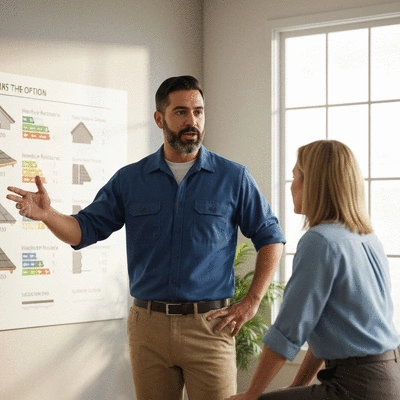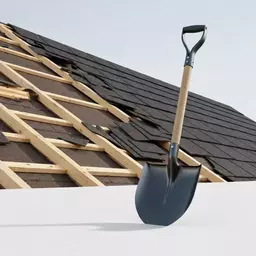Weather's Effects on Your Roof

Posted on: 2025-11-18
By: Jordan M. Knox
Have you ever stopped to think about how your local weather might be silently dictating the lifespan of your roof? Understanding this intricate relationship can save you a fortune in repairs and ensure your home remains a safe haven, regardless of the storms outside.
What You Will Learn
- The critical role climate plays in selecting roofing materials for durability and efficiency.
- How temperature fluctuations and local humidity levels influence roof longevity and performance.
- Key factors to evaluate based on your specific climate zone to tailor your roofing choices.
- The impact of UV radiation on roofing materials and tips for selecting UV-resistant options.
- Essential maintenance steps to protect your roof from wind and rain damage.
- Resources and strategies for conducting comprehensive research before making roofing decisions.
- The importance of consulting professionals for tailored roofing solutions that meet local climate challenges.
Key Influences on Roof Longevity & Performance
Understanding how weather impacts your roof is crucial for ensuring its longevity and performance. The visual below highlights the primary weather factors, their effects on roofing materials, and vital considerations for making informed roofing decisions.
Climate Factors to Consider
- Temperature Fluctuations
- Humidity Levels
- Wind Patterns
How Weather Impacts Materials
- Heat & Energy Efficiency
- Moisture & Corrosion
- UV Radiation Degradation
Informed Roofing Decisions
- Material Durability vs. Weather
- Energy Efficiency Needs
- Tailored Maintenance Strategies
Next Steps for Your Roof
- Climate-Specific Decision Matrix
- Consult Professionals Early
- Find Local, Reputable Contractors
Understanding the Connection Between Weather and Your Roof
Have you ever thought about how weather impacts your roof? As a roofing expert with over a decade of experience, I can tell you that understanding this connection is crucial for ensuring the longevity and performance of your roofing system. Climate not only influences the materials you choose but also determines the maintenance needed to keep your roof in top shape.
In this section, we’ll explore why climate matters when making roofing decisions. By the end, you’ll have a clearer picture of how local weather conditions can dramatically affect your roof's lifespan and efficiency! For more insights on different roofing options, consider exploring various roofing materials pros and cons.
The Importance of Climate in Roofing Decisions
When it comes to roofing, one size certainly does not fit all! It’s essential to consider the climate of your area. Here are some key factors to keep in mind:
- Temperature fluctuations: Extreme heat or cold can affect material durability.
- Humidity levels: Areas with high moisture may require different materials than dry regions.
- Wind patterns: Understanding local wind speeds can help determine necessary roofing reinforcements.
By evaluating these factors, you can make a more informed choice about the best roofing materials and systems for your home.
How Local Climate Conditions Affect Roof Longevity
Local climate conditions play a pivotal role in determining how long your roof will last. For instance, roofs in areas that experience heavy snowfall are designed to handle that weight, while those in arid regions might focus more on heat resistance. Have you noticed how a roof can age faster in certain climates? It’s true!
Factors like UV exposure, temperature extremes, and precipitation can all contribute to roof wear and tear. Understanding these elements helps you choose materials that can withstand your specific climate.

Evaluating Your Specific Climate Zone: What to Consider
Identifying your climate zone is the first step in making the right roofing decisions. Consider asking yourself:
- What are the highest and lowest temperatures in my area?
- How much rainfall or snowfall do we receive annually?
- Are there any common weather-related issues in my region?
Asking these questions allows you to tailor your roofing choices to meet the unique demands posed by your environment. This preparation ultimately leads to a more durable and efficient roof!
Common Weather Impacts on Roofing Materials
Weather can be a roof’s best friend or worst enemy, depending on the material used. Let’s dive into how different weather conditions impact roofing materials.
Heat and Energy Efficiency: The Role of Roofing Materials
Did you know that the roofing material you choose can significantly affect your home’s energy efficiency? Materials that reflect sunlight, such as a light-colored metal roof, can help keep your home cooler in hot climates. This not only saves money on energy bills but also extends the life of your roof!
In contrast, darker materials may absorb heat, which can lead to increased energy costs. It’s important to weigh these factors when selecting your roofing material.
Moisture and Corrosion: Choosing Weather-Resistant Roofing
Moisture is a major concern for any roofing system. Regions with high humidity or frequent rainfall must prioritize weather-resistant roofing materials, such as metal or asphalt shingles with a protective coating. These materials help prevent corrosion and keep your roof safe from rot. Regular seasonal roof maintenance is also key to preventing moisture-related damage.
Choosing the right material can mean the difference between a long-lasting roof and frequent repairs. Remember, prevention is always better than cure!
Understanding UV Radiation and Its Effects on Your Roof
UV rays can be harsh on roofing materials, leading to degradation over time. For instance, asphalt shingles can become brittle and fade when exposed to constant sunlight. Selecting roofing materials with UV resistance is essential for protecting your investment.
Consider options like reflective coatings or special treatments that help mitigate UV damage. This foresight can save you time and money down the line!
Addressing Rain Damage: How to Protect Your Roof
Rain can wreak havoc on roofs, especially if proper drainage isn’t considered. Ensuring that your roof has adequate slope and well-placed gutters is vital to directing water away. Here are a few tips to protect your roof from rain damage:
- Regularly clean your gutters to prevent clogs.
- Inspect for leaks or damage after heavy storms.
- Consider installing a roof underlayment that adds an extra layer of protection.
Taking these steps can significantly increase your roof’s durability against rain damage!
Pro Tip
When selecting roofing materials, always consider the long-term effects of local weather conditions. For instance, if your area experiences heavy rainfall, opt for materials with increased water resistance to prevent leaks and prolong the life of your roof. Investing in quality materials now can save you from costly repairs in the future!
Making Informed Roofing Decisions for Your Home
Making the right roofing choices for your home is crucial, especially when considering your local climate. At Roofing Explained, I often emphasize the importance of comprehensive research and planning. This ensures you select materials that not only fit your budget but also withstand the unique weather conditions in your area. Have you thought about how your roof will perform in heavy rains or extreme heat? Understanding these factors can significantly impact your roof's longevity.
The Importance of Comprehensive Research and Planning
One of the first steps in your roofing project should be understanding your local climate. Why does this matter? Because different materials react differently to environmental stressors. For example, if you live in a region with heavy snowfall, you might need materials that can handle the weight without compromising integrity.
Why Understanding Local Climate Matters in Roof Selection
- Identifies materials that can withstand local weather conditions
- Helps in assessing energy efficiency needs for heating and cooling
- Informs maintenance strategies tailored to your environment
By recognizing the specific challenges posed by your climate, you can make better decisions about which roofing materials will serve you best. This proactive approach can save you money and headaches down the line!
Utilizing Resources to Evaluate Material Options and Costs
There are numerous resources available to help you compare roofing materials, including online guides, local contractor recommendations, and even community forums. Start by gathering information on costs, durability, and energy efficiency. Consider reaching out to industry experts, like myself, for insights that are relevant to your specific situation.

- Online roofing material databases
- Cost estimation tools
- Local building supply stores for material samples
These resources will not only guide you in selecting the best materials but also empower you to negotiate better with contractors by understanding the true value of what you’re getting.
Taking Action: Your Next Steps for Climate-Appropriate Roofing
Now that you have a clearer understanding of how climate impacts your roofing choices, it’s time to take action! At Roofing Explained, we advocate for a structured approach to decision-making.
Creating a Climate-Specific Decision Matrix
Creating a decision matrix can simplify the process of comparing materials based on local weather patterns. This tool will allow you to visualize the pros and cons of various options side by side, ensuring you choose wisely!
How to Compare Materials Based on Local Weather Patterns
- List materials suitable for your climate
- Evaluate durability ratings against expected weather conditions
- Assess energy efficiency based on seasonal temperature fluctuations
Using this matrix, you can make informed comparisons that highlight the strengths and weaknesses of each option. It’s a practical way to ensure your roof meets your needs for years to come.
Consulting Professionals for Tailored Roofing Solutions
While doing your research is vital, consulting with professionals can take your roofing project to the next level. Expert advice ensures that you’re not overlooking any crucial details.
When to Seek Expert Advice on Installation and Maintenance
- Before finalizing your material choices
- During the installation process for best practices
- For regular maintenance checks and advice
This collaboration can save you from potential pitfalls and provide peace of mind throughout the roofing process.
Finding Local Contractors for Quality Roof Work
Finding reliable local contractors is essential to ensure your roofing project is executed flawlessly. Look for professionals who understand the unique challenges presented by your local climate. For help selecting the best professional for your needs, review our guide on selecting your roofing contractor wisely.
- Check online reviews and ratings
- Ask for recommendations from friends and neighbors
- Request quotes from multiple contractors to compare prices and services
By choosing knowledgeable contractors, you’ll enhance your chances of a successful roofing project that will stand the test of time.
Frequently Asked Questions (FAQs)
- Q: How does local weather affect my roof's lifespan?
- A: Local weather conditions like temperature fluctuations, humidity, wind patterns, and UV radiation significantly impact your roof's longevity. Extreme heat/cold can affect material durability, moisture can lead to corrosion, and UV rays cause degradation over time. Choosing materials suited to your climate is crucial.
- Q: What roofing materials are best for hot climates?
- A: In hot climates, materials that reflect sunlight, such as light-colored metal roofs, are highly beneficial. They help keep your home cooler, reduce energy bills, and extend the roof's life by minimizing heat absorption.
- Q: What can I do to protect my roof from rain damage?
- A: To protect your roof from rain damage, ensure adequate slope and well-placed gutters for proper drainage. Regularly clean gutters to prevent clogs, inspect for damage after heavy storms, and consider installing a roof underlayment for extra protection.
- Q: Why is UV resistance important for roofing materials?
- A: UV radiation can severely degrade roofing materials over time, making them brittle and causing fading, especially in materials like asphalt shingles. Selecting UV-resistant options or applying reflective coatings can mitigate this damage, preserving your roof's integrity and appearance.
- Q: How can I choose the right roofing contractor?
- A: To find a reliable local contractor, check online reviews and ratings, ask for recommendations from friends and neighbors, and obtain quotes from multiple contractors to compare services and prices. Ensure they understand the unique challenges of your local climate.
Recap of Key Points
Here is a quick recap of the important points discussed in the article:
- Consider local climate factors—temperature, humidity, and wind patterns—when selecting roofing materials.
- Choose roofing materials that can withstand specific weather conditions, such as heavy snowfall or intense heat.
- Evaluate energy efficiency by selecting materials that reflect sunlight to reduce cooling costs.
- Regular maintenance, such as gutter cleaning and inspection for leaks, is essential to prolong roof lifespan.
- Utilize resources and consult professionals for tailored advice on roofing solutions that meet climate-specific needs.
 Ever faced the daunting task of removing old roof shingles? The right tool can transform this labor-
Ever faced the daunting task of removing old roof shingles? The right tool can transform this labor-
 Have you ever stopped to think about how your local weather might be silently dictating the lifespan
Have you ever stopped to think about how your local weather might be silently dictating the lifespan
 Have you considered how your roof can affect your home's comfort and energy efficiency? Understandin
Have you considered how your roof can affect your home's comfort and energy efficiency? Understandin
